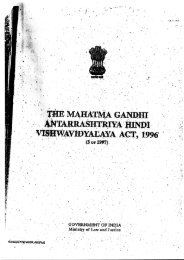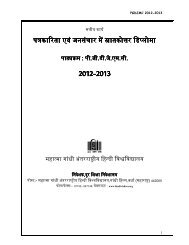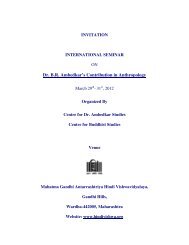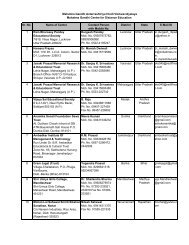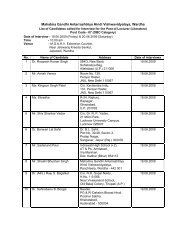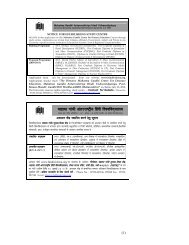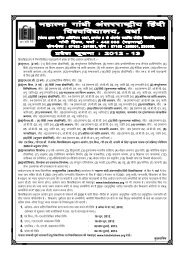A Journal of Mahatma Gandhi Antarrashtriya Hindi Vishwavidyalaya
A Journal of Mahatma Gandhi Antarrashtriya Hindi Vishwavidyalaya
A Journal of Mahatma Gandhi Antarrashtriya Hindi Vishwavidyalaya
You also want an ePaper? Increase the reach of your titles
YUMPU automatically turns print PDFs into web optimized ePapers that Google loves.
significant. Since real aspects like history<br />
and society are negligible in these three<br />
novels <strong>of</strong> Agyeya, these novels are, on<br />
the whole, one - dimensional (existential<br />
- individualistic) and unrealistic (lacking<br />
societal and historical elements). A critical<br />
analysis <strong>of</strong> a creative work expects a realist<br />
depiction <strong>of</strong> society and history and<br />
therefore realist perspective focuses more<br />
on social concerns. An interest in literature<br />
means an interest in man/ woman, society<br />
and civilization. The famous <strong>Hindi</strong> poet<br />
and critic Gajanan Madhav Muktibodh<br />
rightly called criticism as ‘sabhyata -<br />
sameeksha’ (‘critique <strong>of</strong> civilization’). But<br />
unfortunately Agyeya (following Aristotle<br />
who usually talked <strong>of</strong> ‘autonomy <strong>of</strong><br />
literature’ which, in turn, means ‘art for<br />
art’s sake’. But this view may be criticized<br />
on three grounds: first, any art is directly<br />
or indirectly, crudely or minutely,<br />
associated with life because a writer or<br />
artist is first and foremost a human being<br />
and his economic, political and social<br />
conditions affect his art. The inter-connected<br />
ideology, hegemony and other forces<br />
remain active in real life; second, even<br />
the subconscious or unconscious <strong>of</strong> human<br />
mind affects one’s thoughts and forms <strong>of</strong><br />
arts, as S. Freud has rightly proved; third,<br />
as structuralists have pointed out, a creative<br />
writing is to be contextualized and decoded<br />
by the critics or readers in a larger structure<br />
because an author is an agent who encodes<br />
his message from the language (which is<br />
a structure <strong>of</strong> signs)— thus a writer is<br />
not fully original and autonomous in true<br />
sense. We tend to agree with Lukacs who<br />
finds the novels <strong>of</strong> Leo Tolstoy and Balzac<br />
more realistic (despite not being leftist)<br />
than those <strong>of</strong> declared Marxist - novelists<br />
because the former depicted social reality<br />
as reflected in their characterization in<br />
historical contexts. A piece <strong>of</strong> literature,<br />
especially a novel, shows the trends <strong>of</strong><br />
social deviance, tensions, conflicts<br />
contradictions, instability and disharmony<br />
in a contemporary society. But Agyeya’s<br />
three novels somehow lack these<br />
sociological dimensions (hence lack<br />
‘sociological imagination’) because <strong>of</strong> his<br />
closeness to individualist - existentialism.<br />
However, there is no doubt that these<br />
three novels are notable because <strong>of</strong> their<br />
literariness, poetics, idioms, and attractive<br />
style.<br />
Subhash Sharma, born 1959, educated in J.N.U., author <strong>of</strong> ten books<br />
including books in English ‘why people protest, dialectics <strong>of</strong> agrarian<br />
development.’ His main interests include culture, environment, education<br />
and development. He works in Ministry <strong>of</strong> Defence and lives in New<br />
Delhi.<br />
January-March 2012 :: 61




